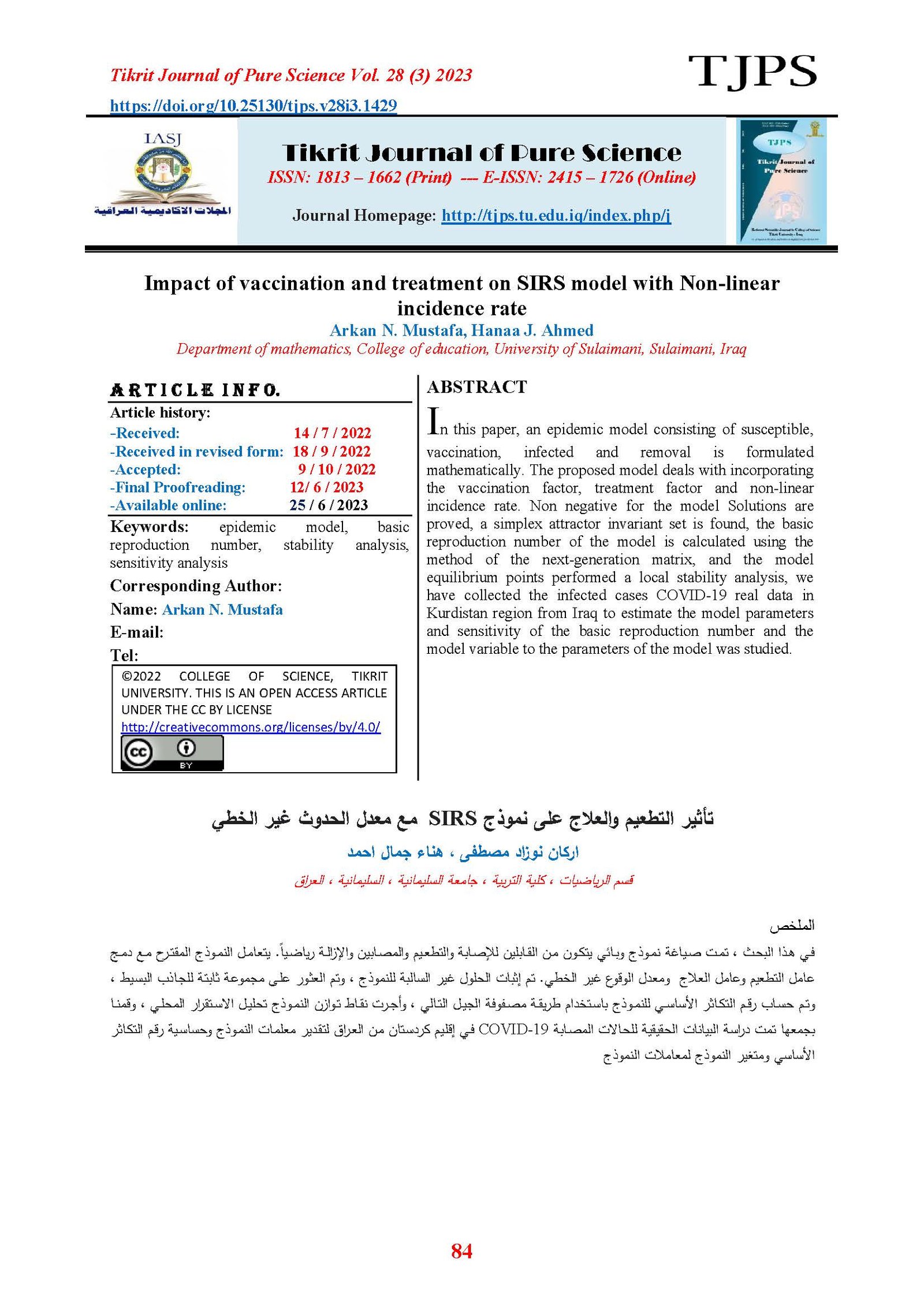Impact of vaccination and treatment on SIRS model with Non-linear incidence rate
Main Article Content
Abstract
In this paper, an epidemic model consisting of susceptible, vaccination, infected and removal is formulated mathematically. The proposed model deals with incorporating the vaccination factor, treatment factor and non-linear incidence rate. Non negative for the model Solutions are proved, a simplex attractor invariant set is found, the basic reproduction number of the model is calculated using the method of the next-generation matrix, and the model equilibrium points performed a local stability analysis, we have collected the infected cases COVID-19 real data in Kurdistan region from Iraq to estimate the model parameters and sensitivity of the basic reproduction number and the model variable to the parameters of the model was studied
Article Details

This work is licensed under a Creative Commons Attribution 4.0 International License.
Tikrit Journal of Pure Science is licensed under the Creative Commons Attribution 4.0 International License, which allows users to copy, create extracts, abstracts, and new works from the article, alter and revise the article, and make commercial use of the article (including reuse and/or resale of the article by commercial entities), provided the user gives appropriate credit (with a link to the formal publication through the relevant DOI), provides a link to the license, indicates if changes were made, and the licensor is not represented as endorsing the use made of the work. The authors hold the copyright for their published work on the Tikrit J. Pure Sci. website, while Tikrit J. Pure Sci. is responsible for appreciate citation of their work, which is released under CC-BY-4.0, enabling the unrestricted use, distribution, and reproduction of an article in any medium, provided that the original work is properly cited.
References
[1] Tillett, H., Infectious Diseases of Humans: Dynamics and Control. RM Anderson, RM May, Pp. 757. Oxford University Press; 1991 (£ 50.00). Epidemiology & Infection, 1992. 108(1): p. 211-211.
[2] Naji, R.K. and R.M. Hussien, The dynamics of epidemic model with two types of infectious diseases and vertical transmission. Journal of applied mathematics, 2016. 2016.
[3] Mekonen, K.G., T.G. Habtemicheal, and S.F. Balcha, Modeling the effect of contaminated objects for the transmission dynamics of COVID-19 pandemic with self protection behavior changes. Results in Applied Mathematics, 2021. 9: p. 100134.
[4] Mustafa, A., jamal,H., Modeling The Effect of Contaminated Object, Vaccination and Treatment on The Diseases Epidemiology. Passer 4 (Issue 2) (2022) 105-112
[5] Rahman, B., et al., How Containment Can Effectively Suppress the Outbreak of COVID-19: A Mathematical Modeling. Axioms, 2021. 10(3): p. 204.
[6] Khoshnaw, S.H., R.H. Salih, and S. Sulaimany, Mathematical modelling for coronavirus disease (COVID-19) in predicting future behaviours and sensitivity analysis. Mathematical Modelling of Natural Phenomena, 2020. 15: p. 33.
[7] Khoshnaw, S.H.; Abdulrahman, K.Y.; Mustafa, A.N. Identifying key critical model parameters in spreading of COVID-19 pandemic. Aims Bioeng. 2022, 9, 163–177
[8]Arino, J., C.C. McCluskey, and P. van den Driessche, Global results for an epidemic model with vaccination that exhibits backward bifurcation. SIAM Journal on Applied Mathematics, 2003. 64(1): p. 260-276.
[9]Gumel, A.B., C.C. McCluskey, and J. Watmough, An SVEIR model for assessing potential impact of an imperfect anti-SARS vaccine. Mathematical Biosciences & Engineering, 2006. 3(3): p. 485.
[10] Wei, C. and L. Chen, A delayed epidemic model with pulse vaccination. Discrete Dynamics in Nature and Society, 2008. 2008.
[11] Gumel, A.B. and S.M. Moghadas, A qualitative study of a vaccination model with non-linear incidence. Applied Mathematics and Computation, 2003. 143(2-3): p. 409-419.
[12] Naji, R. and B. Abdulateef, The dynamics of model with nonlinear incidence rate andsaturated treatment function. Science International, 2017. 29: p. 1223-1236.
[13] Rosa, S. and D.F. Torres, Parameter estimation, sensitivity analysis and optimal control of a periodic epidemic model with application to HRSV in Florida. arXiv preprint arXiv:1801.09634, 2018.
[14] Oluyori, D.A., H.O. Adebayo, and Á.G. Pérez, Global analysis of an SEIRS model for COVID-19 capturing saturated incidence with treatment response. medRxiv, 2020.
[15] Montgomery, D.C., E.A. Peck, and G.G. Vining, Introduction to linear regression analysis. 2021: John Wiley & Sons.
[16] Aldila, D., et al., A mathematical study on the spread of COVID-19 considering social distancing and rapid assessment: The case of Jakarta, Indonesia.
